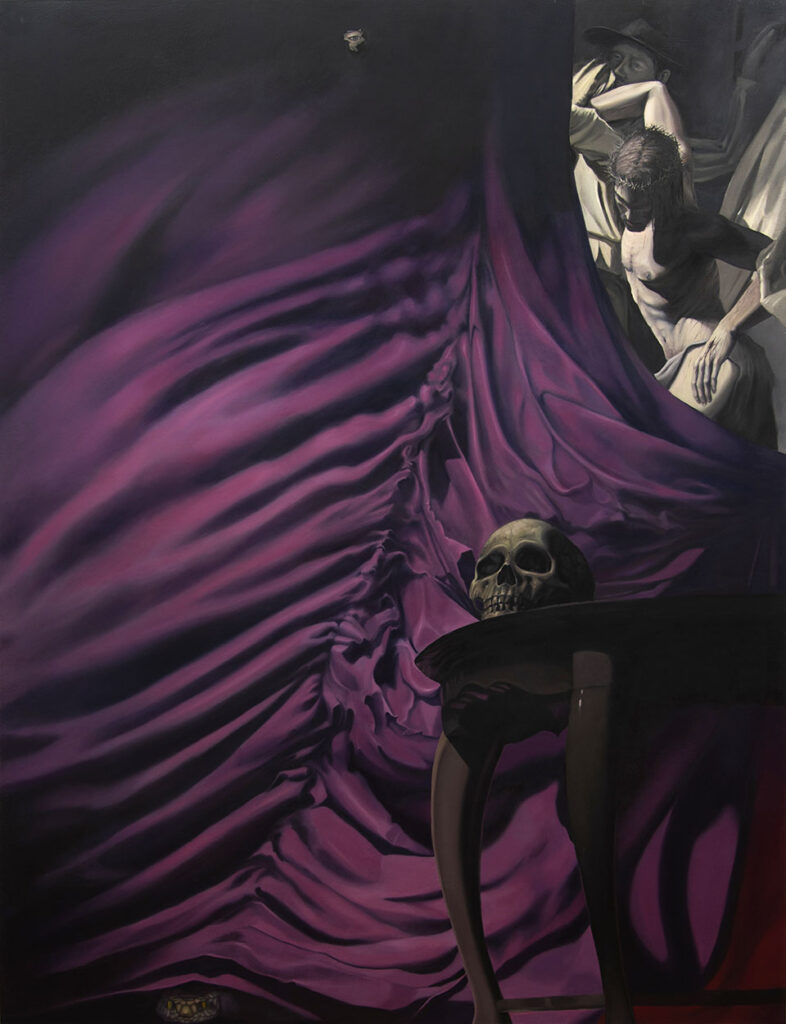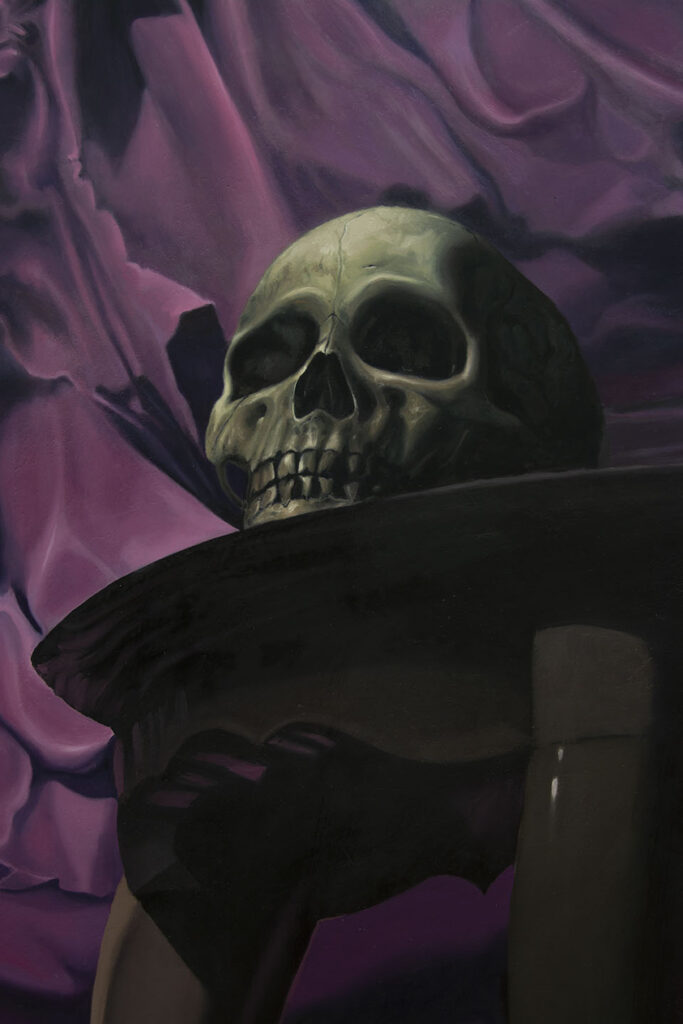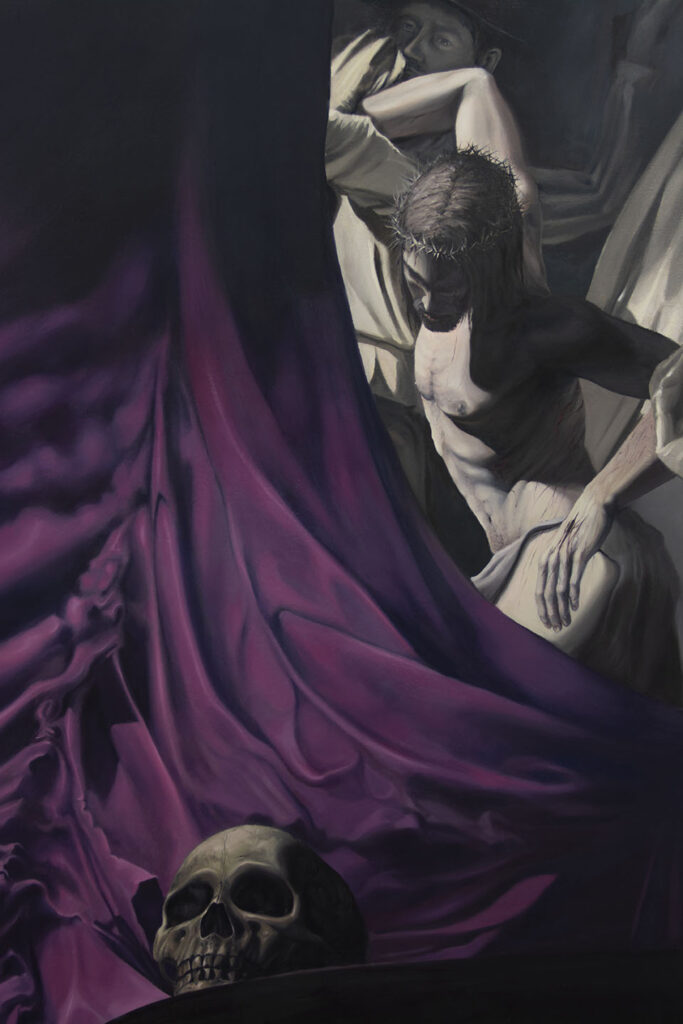„Quodlibet et vanitas morte”
vel the descent from the cross Jesus Christ
In the tradition of European painting, Quodlibet enjoyed great popularity, especially among the Dutch in the second half of the 17th century, when the paintings of Pieter Aertsen or Cornelius Norbertus Gijsbrechts guided the eye and mind of wealthy burghers through a complex game of meanings hidden in the illusionist layer of the painting, for a deeper reflection on the topic of the sacred and the profane. The curtain, as an element of the border, covers what is impossible to see, directly introducing the viewer to the intellectual adventure of additions resulting from the meanings shown in the presentation of the part of the picture that has not been obscured.
Quodlibet w tradycji malarstwa europejskiego cieszył się wielką popularnością szczególnie u Holendrów w drugiej połowie XVII wieku, kiedy to obrazy Pietera Aertsena czy Corneliusa Norbertusa Gijsbrechtsa kierowały oko i umysł zamożnych mieszczan, poprzez złożoną grę znaczeń ukrytych w iluzjonistycznej warstwie obrazu, do głębszej refleksji nad tematem sacrum i profanum.
Kotara, jako element granicy, zakrywa to co niemożliwe do ujrzenia, bezpośrednio wprowadzając odbiorcę w intelektualną przygodę dopowiedzeń wynikających ze znaczeń ukazanych w przedstawieniu tej części obrazu, która nie została zasłonięta.


In the foreground of my painting there is an ascetic still life reminiscent of the ancient sentence memento morii. It is an expression of our material, transient, possible and finite world at the same time. On the other hand, according to tradition, the sacred scene seems to be in the background behind the curtain. A sacred representation of God in the form of a man who was martyred and crucified for our salvation. As much as we understand and study the meanings of the New Testament, we include it in the impossible, non-obvious and metaphorical world. The images of testamentary exegesis permeate our material embodiment. It should seem that this scene should be the main, foreground performance. However, I decide to present it in a manner consistent with the convention, giving the viewer room for interpretation, at the same time presenting it in a peculiar way, seemingly artificial, full of theatrology and staged dramaturgy. An image is a record of a certain more complex thought that we begin to interpret as a result of further discovery. Its illusory formality, which is supposed to be superficial, transient like prophetic materiality, which hides a deeper meaning of the image hidden in the essence of its content, becomes blurred. Hidden behind a veil that the viewer has to discover in his own way, in line with the quodlibet tradition.
W moim obrazie na pierwszym planie jest ukazana ascetyczna martwa natura przypominająca nam starodawną sentencję memento morii. Jest to wyraz naszego świata materialnego, przemijalnego, możliwego i skończonego jednocześnie. Natomiast, wedle tradycji za kotarą, jakby w drugim planie mieści się scena sacrum. Święte przedstawienie Boga ukazanego w postaci człowieczej, który to został umęczony i ukrzyżowany za nasze zbawienie. Jakkolwiek rozumiemy i badamy znaczenia Nowego Testamentu, zaliczamy go do świata niemożliwego, nieoczywistego i metaforycznego. Wyobrażenia wynikające z egzegezy testamentowej są przenikające nasze materialne ucieleśnienie. Zdawać się powinno, że to właśnie owa scena powinna być głównym, pierwszoplanowym przedstawieniem. Jednak postanawiam ująć ją w sposób zgodny z konwencją, dając widzowi pole do interpretacji, jednocześnie przedstawiając ją w osobliwy sposób, na pozór sztuczny, pełny teatrologii i dramaturgii inscenizowanej. Obraz jest zapisem pewnej bardziej złożonej myśli, którą zaczynamy interpretować w wyniku jego dalszego odkrywania. Zaciera się jego iluzoryczna formalność, będąca jakoby pozorem powierzchowności, przemijalna jak profetyczna materialność, za którą kryje się głębsze znaczenie obrazu, ukryte w sednie jego treści. Ukryte za zasłoną, którą to widz musi odkryć po swojemu w zgodzie z tradycją quodlibet.
Oil on canvas. Oil and resin technique, varnished Size: 130 x 170 cm
Olej na płótnie. Technika olejno-żywiczna, werniksowany Format: 130 x 170 cm

